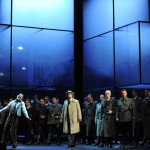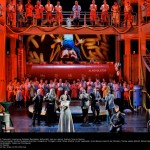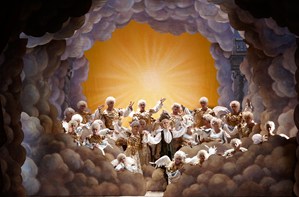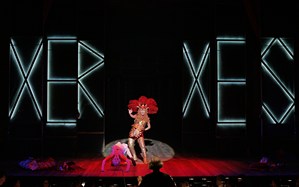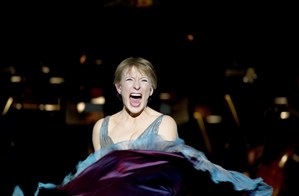The tolerance of German audiences for extreme stage productions is a source of national pride and the envy of many abroad. But a production of Tannhäuser at the Deutsche Oper am Rhein which had to be stripped down to concert performance last week has set off a national debate about the sanctity of a director’s artistic freedom. Two seasons ago, the Bayreuth Festival mounted the same opera in a new production by Sebastian Baumgartner which places the heroine, Elisabeth, in a “biogas” chamber. It caused a moral outcry in the press, but the notion of her being “recycled” rather than outright gassed appears to have kept the staging in repertoire. In Düsseldorf, at the Oper am Rhein, the director Burkhard C. Kosminski went a step too far. Naked extras were already being gassed during the overture. An entire family was shot after its members had their heads shaven by soldiers. Venus was dressed in an SS uniform; Elisabeth was raped and burned. The boos in the small city of Düsseldorf started 30 minutes into the production, according to Der Spiegel, and some audience members were so traumatized that they needed medical attention. Criticism from the Jewish community was just the icing on the cake. But Kosminski refused to modify his vision, for fear of betraying his artistic principles. Less than a week after its premiere on May 4, the opera was reduced to a concert version.
The obvious issue, which audience members were quick to point out, is that Nazis and persecuted Jews have nothing to do with Tannhäuser. The opera is about a pilgrim who leaves Venus’ world of love-making, enters a song competition on the Wartburg, and finds redemption in the saintly Elisabeth. An editorial in the German magazine Cicero , dedicated to the intersection of arts and politics, observes that a director turns to Nazis when he has no good ideas of own. The author continues to criticize Germany’s lavish public funding for theater, calling Hitler its “patron saint.” It may be worth noting that the Deutsche Oper am Rhein, a shared entity of the nearby cities of Düssseldorf and Duisburg, nearly entered financial meltdown last season. Was the production a desperate attempt to lend the company a cutting-edge status capable of competing with the many other opera houses in West Germany (let’s not forget that the reunited country possesses altogether one-seventh of the world’s companies)?
In an interview with Der Spiegel this week, Kosminski states the “real scandal” at hand is “censorship in the arts.” He insists that the production intended to mourn, not ridicule, the victims of World War Two, describing himself as “terrified” by criticism from the Jewish community. Just yesterday, he won the support of the president of the Akademie der Künste, Klaus Staeck, who has written a letter demanding that the production be reinstated. “Art—regardless of its quality!—is not a superfluous luxury,” he argues. Is it then justified to use art as a vehicle for emotional torture? And is quality not an important criterium when good tax money is being invested? From a purely literary point of view, there is little to no basis for casting Tannhäuser as a war criminal who is forced into the SS guard. Surely Greek myth is more important to understanding the opera than Wagner’s indirect connection to the Holocaust as a role model of Hitler.
Although the opera derives its plot in part from Thuringian legend, there is little in the way of nationalist undertones compared to later works such as Lohengrin, Die Meistersinger, Parsifal and, to some extent, the Ring cycle. Patrice Chéreau caused a scandal upon the centenary of the Bayreuth Festival in 1976 by setting the cycle at the time of early German industrialization. This is a loaded topic, given the industrial killings that followed during World War Two, but the production opened the door to historical allegory on the Festspielhaus stage. Stefan Herheim’s 2008 production of Parsifal, which opens in the Villa Wahnfried in the 1880s and ends in the Federal Republic of Bonn, plumbs the possibilities even further. The appearance of swastika flags and black-and-white footage from the Second World War remains controversial, but Herheim caused the audience to think critically about the inextricability of Wagner’s works from his time and the institution of Bayreuth itself.
Kosminski, through his graphic depictions of the violence and genocide, crossed a threshold that was already at breaking point. Although I didn’t see the production first-hand, the audience’s reaction would indicate that he lacked the sophistication of a director such as Chéreau or Herheim. The exploitation of World War Two—not just to artistic ends but in the media and in academia—has reached a point of saturation in Germany that, thanks to the reaction at the Oper am Rhein, should finally be considered cause for concern. Artistic freedom does not license a director to indulge his darkest fantasies or work out psychological issues at the expense of an opera. Do we go to the theater to be provoked, reviled and confused, or enlightened and transported by an interpretation that allows us to penetrate a given work with more understanding and appreciation? Wagner may remain a thorn in the cultural consciousness, but it is not paying respect to anyone—neither the composer, the German people, nor the Jews who were murdered in the Holocaust—to use his stage works as vehicles for cheap, shock tactics under the pretence of creating socially relevant art. As austerity plagues Europe, it is even more shameful to invest in stage productions that ruin rather than illuminate an opera.
